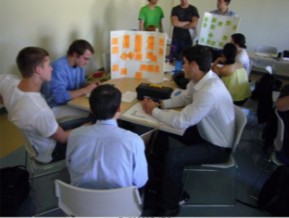Can hardly believe we have had week 3 of the B.Com d-studio. Week 3’s theme was around the critique — a common activity in any design studio.
We had our usual warm-up time — this week it was around drawing insights, an exercise taken from Betty Edward’s book: “Drawing on the Artist Within”. The warm-up was intended to help students move from writing to drawing. We wanted them to be able to express things that they see or feel in another language, in essence expanding visual literacy. It is also good for risk-taking practice in terms of a new mode of thinking and doing. And also a good time to practice silencing the critical voice (the one that says you can’t draw). This is about drawing analogs — words like anger, hopefulness, peacefulness and collaboration. The idea is to use the language of the line — fast, slow, light, dark, smooth, rough — and to avoid drawing pictures. Here is a sample from the Edwards book of students’ analog drawings of “peacefulness”:
Interesting to note the similarities in the types of drawings — the horizontal-ness that seems to be common.
And an example from class…
Ron prepared an exercise in critiquing. As I mentioned, studio-based learning is distinguished by peer review and critique. From Ron’s activity statement:
The Challenge: Among the most distinguishing features of studio-based learning is the peer review or critique. Iteration, after all, is fundamental to design thinking. Critique is fundamental to iteration. what, after all propels iteration but consideration of and response to critique (aka feedback). Yet good critique, effective critique, is difficult to find. You have to learn to make it happen. And making it happen is reciprocal (giving and receiving) and this brief exercise is one initial step towards cultivating “good critique”.
The activity itself involved several steps — identifying what each individual wanted to get out of the critique, pairing up with another group in critique cycles where one group presents a crucial insight and the other group critiques. Team A presents insight. Team B critiques Team A. And then Team A critiques Team B’s critique. It seemed that the energy in the room was high — and as a result it seemed difficult to get these steps to happen in a distinct way.
Ron and I have yet to debrief on this exercise so I am sure there is more learning to come.
But here are some photos of critiques in action.


